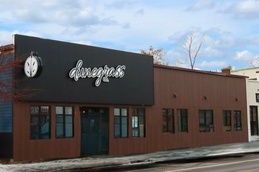Local Money: Plan for Homegrown Currency has a Rich Past
Nov. 12, 2003
The American dollar is an international currency – and that is a problem accordingto Chris Grobbel and Natasha Lapinski of the Traverse Area Community Currency
Initiative (TACCI). A loose coterie of about 20 to 30 activists, the TACCI is working to create some form of money that will stay here. “Big box stores funnel money out of our community
with a predatory way of dealing with our community,” says Lapinski.
About 30 cities, towns and neighborhoods in America, and perhaps 300 more in
Europe and Asia, have some form of local currency. Among the best known in America
are the “Time Dollars” of Ithaca, New York. Each note is worth one hour of labor (or a
common fraction of an hour) with everyone’s time valued the same. Time dollars are
cross-denominated into federal money to make them easier to spend on groceries and other
goods. In Ithaca, an hour is worth $10; the San Francisco alternative currency is pegged at
$12 per hour.
Other plans work differently in other places. In Toronto, the local money is tied
directly to the Canadian federal dollar. Only merchants can redeem the local money and
then only for 90 cents on the dollar. The 10% profit goes into a community fund for
allocation to community resources. Furthermore, Toronto dollars have an expiration date
on them. When a tourist takes a Toronto dollar home, they effectively donate the entire
value of the note to the community.
According to Chris Grobbel, Toronto earns about $30,000 per year from its local money. “Tourism benefits the few,” he said. “And the rest of us bear the cost. A local currency works against that trend by retaining the wealth. It rejuvenates the local middle class.”
LOOKING BACK
At the recent Bioneering Conference in Traverse City, Rob McClure, co-founder of Madison
Dollars, shared a presentation about community money with Grobbel. After the
presentation, McClure said that he was surprised at the interest from collectors. “They
seemed to be willing to pay whatever we asked,” McClure said.
Collectors (called numismatists) know of several kinds of Grand Traverse regional money. Most of these issues came from merchants such as Lautner and Milliken. They were good for five cents to $1 in trade at the issuing store, dairy, or tavern.
Michigan’s merchant tokens are enumerated in a 350-page compendium by Paul
Cunningham. Published in 1982, it is always being updated by independent researchers
who are members of MichTAMS, the Michigan Token and Medal Society. Former
MichTAMS President Paul Manderscheid of Lansing, recently published an updated list
for Leelenau County and is working on another for Traverse City.
During the Great Depression of the 1930s Traverse City was one of several
hundred communities that had its own currency. Perhaps the first was the town of
Tenino, Washington. When the only bank in town closed on December 5, 1931, people
still had the same assets and liabilities they had the day before. All they needed were tokens
or counters to keep track of their incomes and purchases. So, the local newspaper of that
logging community printed thin, bill-sized slats of wood to be used as emergency money.
TRAVERSE CITY‘S SCRIP
Traverse City launched its scrip on March 9, 1933. Spearheaded by the Chamber of
Commerce, the plan was approved by the city commission after a week of behind-the-
scenes discussion. During that time, the Record-Eagle carried stories and pictures about
scrip, prosperity checks, and trade dollars from Detroit and Howell, as well as Martins
Ferry, Ohio, and Clear Lake, Iowa.
The first issue of Traverse City scrip was for $2,000, denominated in $1 and 50-
cent notes. The money paid wages of $2 per day to unemployed men not already on
welfare. The 150 men were organized into rotating crews of about 30. Crews worked for
four nine-hour days. They cleared brush from the streets and roads, and cleaned the banks of
the Boardman River below Park St. On March 31, the city issued another $2,000 in scrip.
Clinch Park, Cass St., and Union St., benefited from the labor. About 200 cords of wood
were “buzzed up” at the city gravel pit and distributed to needy families.
Basically a loan from the business community to the city, these scrip certificates
were self-liquidating. The city issued the money as wages. Every merchant or business that
received a note, affixed a stamp to the back. Merchants bought the stamps from the city
treasurer. The 50-cent notes took one-cent stamps; two-cent stamps went on the dollars. The
certificates had to be spent at least once every seven days. After 52 transactions, the bills
could be cashed in. The four percent profit went to the city. The scrip circulated for two years, long past the banking crisis of March 1933. First Peoples State Bank even accepted them for
interest payments on its loans to businesses.
KEEPING THINGS LOCAL
Bob Struthers, the general manager of Oryana Food Cooperative, is one of the
merchants behind the idea of a local currency. “Keeping things local is right up our alley,”
he said. “We are willing to try whatever comes along. Whatever the group decides will be
the biggest factor in the impact on us, and it depends on the model. Even a worst case
scenario is only a worst case; it does not threaten the store.”
Among the alternatives that Struthers envisions is paying a part of the wages to workers in local currency. The local money would then be spent with alternative healthcare providers, and others, who would then bring the money back to the store for purchases. Lapinski and Grobbel point to local agriculture, crafts, and trades as other likely participants.
How local currency ties into tourism is not entirely clear. As in the case of Toronto,
when tourists leave with local money, they invest in the community that they enjoy
visiting. You can gauge the flow of tourist dollars into the Grand Traverse area by looking
at the money in your wallet.
One-dollar bills are the easiest to track. On the front of the note, to the left of
George Washington, is a large black alphabet letter in a black circular seal. This letter and
seal identify the Federal Reserve Bank that the dollar came from. Traverse City is in the
Federal Reserve District for Chicago. Chicago’s letter is G. Also, to the left of this seal is a
number that matches the letter. G is the seventh letter of the alphabet, so notes from Chicago
have a 7 to the left of the seal with a G in it.
These are the Federal Reserve codes. A1: Boston. B2: New York. C3: Philadelphia.
D4: Cleveland. E5: Richmond. F6: Atlanta. G7: Chicago. H8: Minneapolis. I9: St. Louis. J10: Kansas City. K11: Dallas. L12: San Francisco. (There is no Detroit Fed. When the
system was created in 1912, Detroit was unimportant.)
THE MONEY FLOW
Generally speaking, Michigan banks such as Fifth/Third and Huntington, get their newly printed and bundled money from the Chicago Federal Reserve. (Credit unions are on a different system.) Chicago notes tagged G7 are our local, Michigan federal currency. Anything else was imported.
Statistically speaking, we see a disproportionate amount of money from San Francisco.
We get noticeably less from New York, Atlanta, and Dallas.
Before the Great Depression, in order to create a local national bank, the bank’s
board of directors had to deposit with the federal treasury a certain amount of gold (not
silver). The gold served as the reserve to back the notes. These were federal notes with the
name of the local bank on them. The National Bank of Traverse City was part of this
system.
Today, all federal money is created entirely from debt. The assets of the Federal
Reserve banks are Treasury notes. “T-bills” are backed by your ability to pay taxes. Loans
from the Federal Reserve banks to local banks become loans to businesses and credit cards
issued to consumers. It is this system of debt-for-dollars that the TACCI wants to replace
with a local currency.
GETTING STARTED
“About a year ago, Natasha and I were reflecting on the community assets here,”
said Chris Grobbel, who holds a doctorate in community development from MSU.
(Lapinski is a biologist with a master’s from NMU. They are the engines of creation at Ball
Environmental.) “We saw how a viable food economy had developed, how Oryana Co-
op had grown. Land conservancies were successful. Over this was the ethic of reinvesting
in the community and the environment. The piece that was missing was a local currency. I
had traveled to other communities that had local currencies and I recalled that there was
such an effort made here about eight or ten years ago.” Lapinski and Grobbel began talking
to other area activists, gathering information, views, and momentum.
At the Bioneering Conference, Madison Dollar co-founder Rob McClure said that
this long gestation period is commendable. According to McClure, Madison Dollars sort
of took off before anyone knew where it was going. That fact does not worry Oryana’s
Bob Struthers. “We have a willingness to participate,” he said. “It focuses interest in our
community and gives us control over our money, especially for a small business. It will
take time to build the momentum and there will be adjustments.”
Lapinski and Grobbel intend to formalize the structure of the Traverse Area
Community Currency Initiative within six months. Whether that is a corporation, a co-
operative or something else remains to be seen, they said. Also undecided is the final
model for the new money, whether “time dollars” or another plan. Their goal is to have the
money ready for distribution by the summer of 2004.
-30-
CUTLINES:
The orange and/or green Scrip Certificates must be credited to Richard Bond, Coins and
Collectibles.
The tokens (Lauer, Dance Hall, Milliken, etc.) must be credited to David Croad, Coins and
Collectibles.
Trending

Michigan’s Marijuana Tax at Work
Cannabis has become a big business in northern Michigan, and local governments are putting tax dollars earned from dispensar… Read More >>
California Sober: Why People Are Switching from Alcohol to Weed
They call it “California sober.” Generally speaking, this term applies to folks who use marijuana but abstain f… Read More >>
The Legacy of Student Activism
“It’s a physical letter to your representative,” Alex Tank says when asked to define the word “prote… Read More >>


